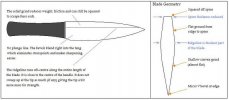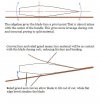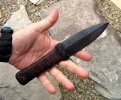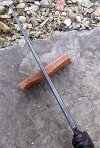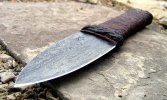- Joined
- Jan 6, 2005
- Messages
- 9,680
Hello all,
I have been toying around with a new blade geometry and REALLY like it. It's got a bit of Japanese/Tribal influence to it. It looks cool but the design is based on function rather than style. I was trying to make a light knife with more rigidity and resistance to flex. Please be honest and tell me what you think.
My attempt at addressing the "strength vs thickness vs cutting ability" dilema.
Rick
I hope you can read the pics.....



The prototype... that you may have seen before...



As forged.... cleaning up the bevels...

A similar blade showing grind lines...

I have been toying around with a new blade geometry and REALLY like it. It's got a bit of Japanese/Tribal influence to it. It looks cool but the design is based on function rather than style. I was trying to make a light knife with more rigidity and resistance to flex. Please be honest and tell me what you think.
My attempt at addressing the "strength vs thickness vs cutting ability" dilema.
Rick
I hope you can read the pics.....



The prototype... that you may have seen before...



As forged.... cleaning up the bevels...

A similar blade showing grind lines...

Attachments
Last edited:

